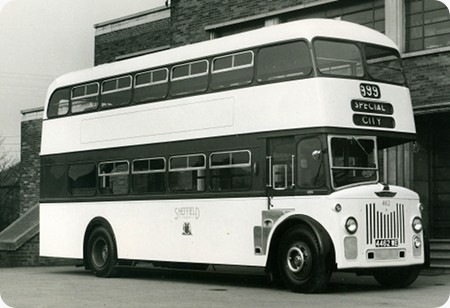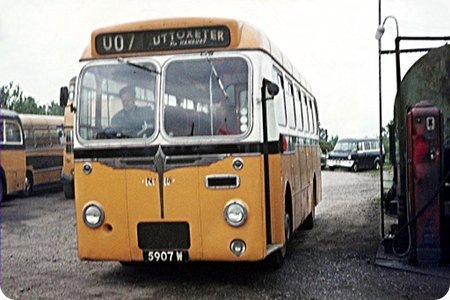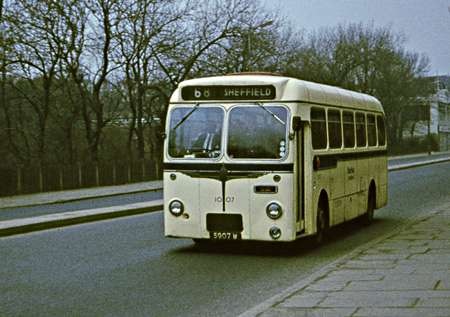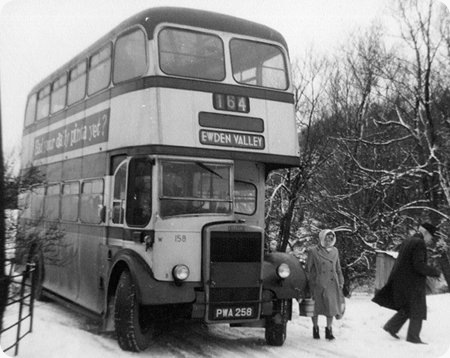Sheffield Corporation – Leyland Titan PD3 – 4462 WE – 462

Copyright ‘unknown’ if you know please get in touch
Sheffield Corporation
1959
Leyland PD3/1
Roe H39/30R
This was one of the first 30ft long double deckers for Sheffield and was one of a batch of 30 similar buses. In a typically perverse way these buses, all for the A fleet, were numbered 461-476 and 901-914. Logic suggests they should have been 901-930 but gap filling seemed to be a Sheffield speciality. Following the closure of Northern Coachbuilders and the body building facility at Leyland Motors in the early 1950s, Sheffield dual sourced bodywork for their new double deck deliveries from Weymann and Roe until Alexander and Park Royal came into favour. The Roe body in this 30ft rear entrance form and with the elegant Sheffield livery was a design classic. I wonder if anyone can explain why Roe bodies for Sheffield were painted in this style whilst those from other bodybuilders had the more conventional three blue bands. 462 was new in March 1959 and is seen outside the Roe factory premises prior to delivery. Similar vehicle 904 is preserved.
Photograph and Copy contributed by Ian Wild
A full list of Titan codes can be seen here.
30/03/11 – 10:00
Before becoming the 42/53 route with Atlanteans, the 38 was primarily and AEC route. For a short while, in the mid sixties, the 901 – 914 suddenly replaced AECs overnight. [It was years before I realised that there were proportionally more Leylands in the fleet.] There must have been a reason, but I never discovered what it was.
I was, and remain, an AEC man and was most displeased. Old age and experience have placed Leyland as a much loved second – but these vehicles had the mitigating feature of those beautiful Roe bodies. The 38 was East Bank, the 461 – 476 were from another garage and I rarely came upon them except "in town". …..and I don’t know why Roe, and certain Leyland bodies, had their own special livery either.
David Oldfield
30/03/11 – 14:38
What a great photograph Ian and what a lot of memories it evokes from when we both lived in Sheffield and travelled up Greystones Road on the "74" between our respective homes. I guess the 74 was an unusual route for Sheffield in that it didn’t cross the city but meandered around the southern suburbs. Like you in one of your earlier comments I remember the winters in Sheffield with snow on the ground but the buses kept running, always got us to school. How things change!
Stan Zapiec
31/03/11 – 16:00
I agree wholeheartedly with Ian and David that the proportions and original livery of the PD3/Roe produced one of the finest looking buses to grace the Sheffield fleet. On the question of livery style, Keith Beeden has stated that in the case of the original batch of PD2/Roe 386-394, the Roe design did not offer an easy adoption of the STD cream and azure blue with three bands and that it was agreed that the livery should be of the ‘simplified style’ quite similar to the Farington scheme as seen on the all Leyland PD2s of 1949. This resulted from the difficulty at the time of accommodating the standard Sheffield destination display which of course with early Roe deliveries was of a side by side style. Presumably, this livery was considered appropriate for all future Roe deliveries despite the standard display being accommodated in due course with effect from the Regent 3’s of the 168 series. We know of course that subsequently, many Roes were repainted in ‘standard’ livery but to my mind, it was nowhere near as elegant. My personal opinion is that in painting the ‘bars’ black between the destination display in the early 60’s, disfigured the look of Sheffield buses in one fell swoop although I believe the general manager of the day also reinstated the cream roof for which credit is due. I cite the present livery scheme of preserved 904 as an example of ‘disfigurement’ but as I said, it is purely my opinion and others will no doubt like it.
Whilst we are on the subject, does anyone remember that AEC/Regent No. 8, FWJ 808, also wore a version of the Farington livery in the late 40s or early 50s.
John Darwent
01/04/11 – 07:28
Sheffield 904 as preserved carries the later cream with bands livery and looks superb. A slightly earlier Roe bodied Titan PD2 II56 is also preserved and wears the blue window livery. This is a high backed seat bus used on C fleet long distance services.
As well as 904 in the final livery with cream bands Leyland Titan PD2-Roe 1156 3156WE of 1058 is also preserved and carries the livery with blue window surrounds on both decks.
Chris Hough
01/05/11 – 07:48
In reply to John and Ian, I can add further information to the Roe style of livery applied to Sheffield double deck buses.
The query about AEC Regent No.8 actually is the start of the case in question. Leyland Motors Ltd. delivered a large fleet of PD2/1 chassis with the new Farington body design. The former lower waistrail feature was eliminated, as was other external beading. Leyland advised Sheffield T.D. to the effect that it would be difficult to apply the usual cream livery with three blue bands. Possibly a suggestion that extra cost would ensue if the standard livery was still required, led to Sheffield looking to simplify the painting style.
Regent FWJ 808 was chosen to explore the possibilities and was out shopped in a bland style of all over cream with blue window surrounds. This eliminated the blue bands but the overall image was poor. A slight improvement, that included a little more blue, led to the adoption of the new style for all the Farington PD2’s. A similar situation arose with the Roe bodies, where the patented waistrail did not adapt to the three blue bands style and also lack of upper beading. Therefore, it was deemed expedient to apply a similar livery to the Farington style.
I hope that this will clarify matters.
Keith Beeden
23/03/13 – 07:56
I believe the reasoning behind the different paint schemes in use on Sheffield buses was purely financial. Some bodies had beading in different places to others and thus the joint between different colours were easier to apply on some rather than others. The placing of masking would add extra cost which on a big batch of vehicles could amount to quite an amount of money which some authorities would be averse to spending on buses!! The characteristic Roe waistline bulge is one awkward bodybuilders addition in question.
Brian Lamb
Quick links to the - Comments Page - Contact Page - Home Page




